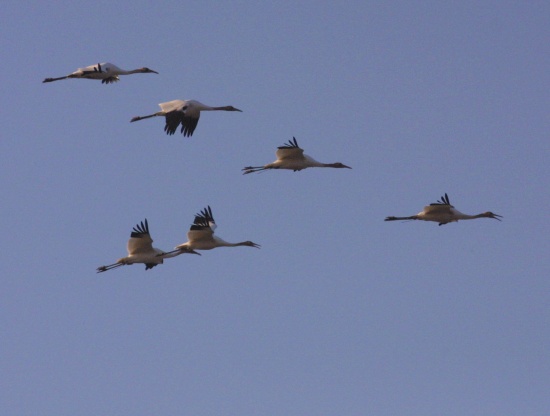Staying
Down in Wind (+
0 Miles)
December 11, 2008: Migration Day 56
|
Photo
Study: Find the cranes in the lead and third positions. What
do you notice about their beaks? What
are two possible explanations? On a day when the birds had
to do a lot of flapping to gain altitude, which reason do you
think is most likely? |
Arrival in Alabama will have to wait one more day. The powerful north
winds are rocking the RV's on the ground, and racing aloft
at more than 40 miles per hour. But tomorrow's forecast
looks promising for a flight!
For the first time this year, the cranes and planes will not need to cross the biggest obstacle of the migration path: the mountains of Tennessee. Last year, after 11 down-days of waiting and two tries to cross the mountains, the team took a break on Dec. 18. Some went home for the holidays. Finally, Dec. 29, brought the right weather and they conquered the 2,500-foot Walden Ridge. You can guess why they call it "The Beast." This year the route will go through Alabama instead. No mountains! Open, flat areas with fewer trees are safer for cranes and planes. Alabamians are excited to have four stopovers in their state, and to see the cranes and planes for the first time. Will it be tomorrow?
In the Classroom:
|
|||||
| Migration History: On December 11, 2007, the six off-course direct autumn release (DAR) crane-kids were captured and moved to Hiwassee Wildlife Refuge in Tennessee. Richard and Eva made the capture and 7-hour drive to Hiwassee, where thousands of Sandhill cranes and nine other older Whooping cranes were on a migration "rest stop." Did those 2007 DAR chicks make it to Florida after all? Find out on their bio pages; click on "The Chicks" in the navigation bar at the bottom of this page. Then scroll to the very bottom of that page and click on "2007" to find the Class of 2007 photos and bio pages. Scroll down to the Group 2 (the DAR chicks) and click on their photos for their stories. | |||||
Journey
North is pleased to feature this educational adventure presented in
cooperation with the Whooping
Crane Eastern Partnership (WCEP).




